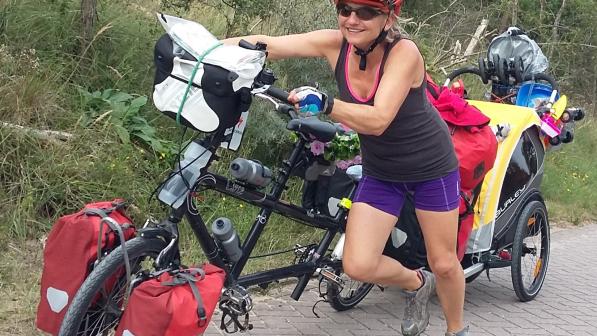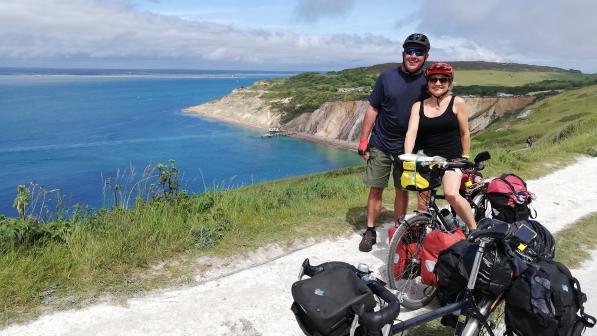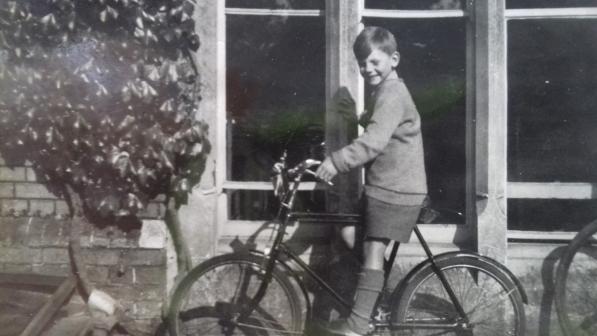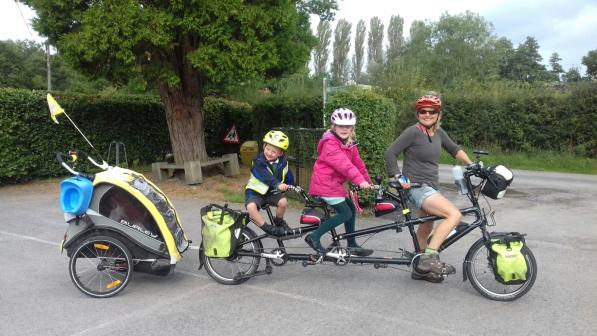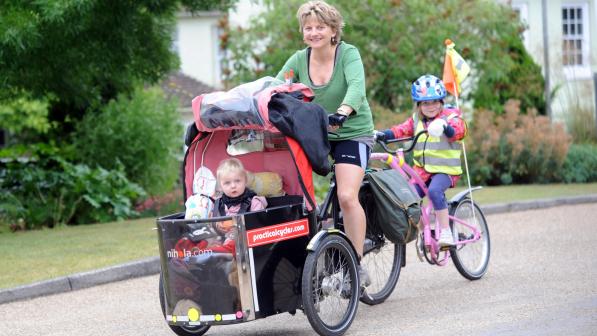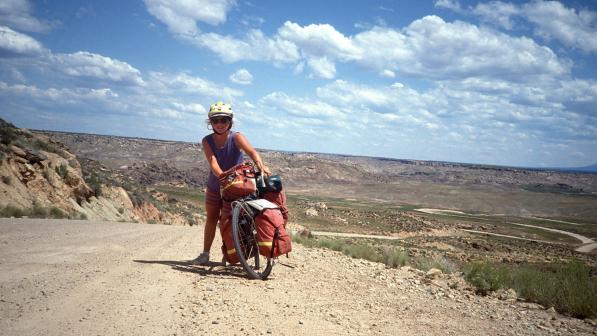Josie Dew's North Sea Cycle Route

The wind in our wheels
The North Sea Cycle Route with noisy offspring: that was CTC Vice President Josie Dew’s back-of-an-envelope plan for the summer holidays
Not long before I gave birth to Jack, I decided it was high time to give my two daughters, Molly (5) and Daisy (2), a taste of touring. Abandoning plans to ride the End to End, we settled on somewhere more cycle-friendly than the UK. Destination Denmark, via Germany and the Netherlands!
Just getting to our ferry in Harwich was an adventure. In the old days, pre-offspring, I used to cycle the 200-odd miles from home to Harwich – or, if pressed for time, put my bike in the guard’s van on the train. These days, huge caged guards’ vans are non-existent and it’s impossible to convey a tandem, a bike, a trailer, a load of panniers, and two young children in one easy move. So we hired a people-carrier for our clobber.
Thanks to road closures and an eternity of tailbacks, we had to jettison the hire car in Colchester instead of Harwich, which meant a 25-mile wild goose chase of a ride following snaking Essex estuaries and dark country lanes. Molly was on the tandem with me, husband Gary following in my slipstream towing Daisy in the trailer. Somewhere near Weeley or Thorpe Green, Molly said, ‘Mummy, Daddy’s not behind us anymore!’
I stopped. After five minutes, a bike light wobbled into view. Gary was attached to it. He’d had to stop as Daisy had woken up with a yelp when an avalanche of camping clutter had landed on top of her. We zoomed off again, screeching to a halt at Harwich International Port at 10:10pm, five minutes before check-in closed. Perfect timing! The check-in man said: ‘I have four passports in my hand but I can only see three of you. Who’s missing?’
‘There’s one in the trailer,’ said Gary. ‘Under all those bags. I think you might just be able to see an ear.’

Among the dunes
We arrived in the Hook of Holland at dawn and disembarked into a cold rain sweeping off the North Sea. Fortunately the crisp blue-uniformed armed guards at passport control also doubled-up as weathermen. They told us in perfect English that the rain was forecast to stop by midday and the afternoon would be bathed in sun.
And so it turned out. We were blown at a rate of knots along the glorious car-free cycle tracks that surfed the undulating sand dunes up the North Sea coast. After stopping at several playgrounds, and working our way through a small mountain of ice creams, we arrived mid-afternoon in the seaside town of Katwijk, pronounced Cat-Vike, but which we initially thought was pronounced Cat-Vick and which Molly called Cat Sick. To get to Cat Sick, we’d had a fantastically fun ride bouncing along perfect bike paths, skirting towns and cities like Den Haag and Monster (‘What’s that coming over the hill / Is it a monster?’ we sang, mindful of The Automatic’s song, Monster.
That night we camped among the dunes in De Zuidduinen campsite. Molly and Daisy had spent the latter part of the afternoon running the equivalent of half a marathon on the near-empty and endless white-sand beach. They both conked out the minute they hit their sleeping bags, not even noticing the thunderstorm that detonated over our heads during the night.
Before I gave birth to my small fleet of mini cyclists, I never used to plan, I just let things happen. I’d head off on my bike with my tent, with a rough idea of the country or continent I wanted to cycle to. I’ll cycle to Sweden, I’d think. And then I’d end up in Poland via Iceland. Or I’d set off to New Zealand and end up cycling around Japan.
It’s not that I got lost or couldn’t read a map, just that I would find a road that looked more interesting than the one I was on and then head down it. I liked leaving things to happy chance. When I woke up in my tent in the morning, I never knew where I would go that day, or what I would eat or where I would sleep. I liked that sense of unpredictability. It keeps you on your toes and sends all senses into overdrive. I had no phone, no iPad, no iPod, no computer. Just a map, a compass, a Swiss Army knife, and a mini shortwave radio. Simplicity in a bag. The ultimate freedom.
Travelling with such young children, we had to go at their pace, stop a lot and throw in a lot of off-bike entertainment: playgrounds, swimming, kite-flying, ball games, beaches, running races, ice cream eating."
Josie Dew, Cycling UK Vice President
The joy of failing to plan
But now, cycling up the North Sea coast of Holland and Germany to Denmark with Gary and the girls, I had to try to be a bit more organised. For the first time in 30 years of cycle touring, I had other people to consider. Before we left home, Gary had said: ‘I don’t think we can cycle like you used to cycle, Jose. We’ll have to know where we are going to spend the night – we’ve got little people to think about.’
And although I knew he was probably right, I don’t really know how to do that. It’s not in my system to be tied down to a locked-in itinerary. All the spontaneity of blowing with the wind flies out of the window. And I find it practically impossible to book ahead as the very nature of travelling by bike is unpredictable: you don’t know which way the wind will blow, which bits of innertube are going to explode, or which bits of bike (or body) are going to fail. We didn’t know how far the girls could manage in a day, or how many playgrounds they wanted to stop at (most of them) or how many beaches they wanted to charge about on (all of them) or how many ice creams they would want to consume (far too many). All of which takes time. So if you have booked accommodation, you then have to keep pushing on and on and all the fun and frolics disappear. So, in the end, we left things to chance. We had our tent so we always had somewhere to stay.
Escaping a storm
Still, there are days when trying to find even a little patch of land on which to pitch your rip-stop nylon home can prove quite a conundrum. And then there’s the weather. One afternoon, we entered the Dutch seaside town of Zandvoort. It was hot and humid. We parked the bikes on the seafront and sat eating ice creams overlooking the long wide white-sand beach and a hazy horizon alive with a forest of turning sails from an enormous offshore wind farm – a slightly unsettling view, like the frantic waving arms of a thousand drowning swimmers. More menacing than this was the speed at which the blue sky began to be eaten by thunderheads, brilliant white on their peaks but black and ominous at their bases.
We had been hoping to cycle for another hour or so, but not wanting the girls to be caught out in a storm, I thought it best to search for a room fast. A line of hotels and B&Bs lined the street behind the seafront and I ran the length of the lot but they were all full. Finally, we raced to the edge of town where a man had said there was a campsite. By this stage we could see the rain approaching in a solid black sheet across the sea. The campsite was expensive and packed full of people hurriedly taking in their washing and zipping up tents. The only space left was a littered bit of dirt behind the toilet block. I didn’t fancy it and said to Gary, ‘Let’s just dive into the campsite shop for shelter and see if the storm passes?’
We made it just as the first fat raindrops exploded on the tarmac. Then the skies erupted, thunder cracked, and the rain hammered down for the better part of an hour. And then it was gone. The sun came out; the roads steamed. We shook the rain off the bikes and flew along with a wild ion-charged energy through the very splendid National Park of De Kennemerduinen, which lies just north of Haarlem. But no camp spot came our way before we had entered the seedy side of Ijmuiden, where we passed a hubbub of police activity and a white forensic tent covering a body.
As the day darkened again, we found ourselves on a ferry crossing the immensity of the Noordzee Kanaal, our little flatbed roll-on roll-off dodging the floating bulk of liners and container ships heading to or from the North Sea and up to Amsterdam. I asked the ferry man if he knew of anywhere to camp the other side but he just shook his head. An elderly couple, whose combined age must have been about 170, spoke no English but did a lot of nodding and gesticulating for us to follow.
We puffed in their wake as they tore along a maze of suburban cycle paths at an average speed of 17mph. One last directional hand gesture and they were gone with a smile and a wave, leaving us to ride the last few hundred metres to a small field behind a steelworks. Here we put up our tent next to a caravan containing a friendly Dutch woman called Trudie, who gave Gary a mug of thick black coffee and the girls a pile of pens and colouring pads.
Molly’s Geburtstag
And on it went, days and weeks of unplanned nights, but always something turning up. One time we ended up camping in a field on the Dutch island of Texel, when we were spotted by a German family who delivered a big pot of pasta and a chicken hotpot to our tent. Another time, east of Bremerhaven in Germany, I asked a stout farmer called Otto if we could camp on his farm, and before I knew it he kicked out a farm worker from his room in an outbuilding so that we could sleep there, albeit in a bit of squashed heap in the one bed.
Then one night, after crossing the mighty Elbe, we found ourselves in the German town of Brunsbüttel that lies at the mouth of the Nord Ostsee Kanal. After nearly five weeks of camping, the girls looked like grubby urchins so I thought it was time to treat them to a hotel, especially as it was Molly’s sixth birthday the next day. Unfortunately, due to Brunsbüttel’s proximity to a nuclear power station, every room in town was full of power station workers.
As the sun slid low in the sky and we stood astride bikes in the street pondering our next move, a small, elderly German woman pulled up in a car. She spoke no English but had sensed our predicament and launched with gusto into making a series of urgent-sounding phone calls to places she thought might have a room. All her attempts ended in a nein, nein shake of head and downcast look before she tried another number. Then a man appeared pushing a bike. He also spoke no English but he did stick all of his fingers in the air, which I interpreted to mean, ‘Wait here – I’ll be back in ten minutes!’
Ten minutes came and went. Molly wilted with weariness over the handlebars of the tandem, Daisy fell asleep in the trailer, the stocky German woman continued to jabber into her mobile phone, and Gary thought we had best move on out of town to find somewhere to camp. But I felt we needed to wait for the ten-fingered man to reappear as I had a feeling something good was going to come of it. Finally, after half an hour, the ten-fingered man appeared, looking jubilant and beckoning us to follow him on our bikes. We danke schön’ed our mobile granny, gave her a big pat on the back for her efforts, and then took off after the man.
He took us to a bungalow belonging to another granny, this one in her eighties, called Gerda Stücker. Gerda spoke no English but welcomed us into her home with open arms, presenting us with our own double room with en suite shower and kitchen. It was the most perfect place to end a fantastic day of unpredictability. The next morning, Gerda and her daughter Marian knocked on our door, singing happy birthday to Molly in German and holding a homemade birthday cake alight with candles. You don’t get that sort of heart-warming spontaneity with a rigid itinerary.
Back to school – eventually
From Brunsbüttel, we kept cycling north towards Denmark, following the flat and wild windswept coast swarming with the magnificent sight and sounds of thousands upon thousands of seabirds. Time was fast running out. From Gerda’s house, it was still about 200 miles to Esbjerg, which is where we hoped to catch a ferry back to Harwich. It was now the beginning of September and Molly was due back at school.
When you are by yourself, you can just keep riding and riding, pressing on and on. But with the girls on board, there was no way we were going to make it. I wasn’t too worried: school seemed like another world away. The washed uniform, the polished shoes, the reading folders, the packed lunchbox, the rushing out of the door in the mornings.
Molly said, ‘This is far more fun than school!’ And I agreed with her.
‘Why don’t we just forget school and keep going to Sweden and Norway and Iceland and Lapland?’ I said, looking hopefully at Gary. ‘We could make it to Santa’s grotto by Christmas!’
But Gary’s not as keen on cycling as me. His motto for the past few weeks had been: ‘Call this a holiday, Jose? It’s more like penance!’
The evening before the new term began, I rang a neighbour at home who works at the village school.
‘Hi Fiona,’ I said, ‘It’s Josie. I think we’re going to be a bit late back to school.’
‘Oh… ok…’ said Fiona a little cautiously, knowing my ways. ‘How late is late?’
‘Only about a week,’ I said. ‘We’re still cycling up the coast of Denmark!’
But what a week! We jam-packed it full of spectacular seascape cycling, jellyfish hunting, open-air Viking museums, murmurations of starlings, camping beside bizarre-looking six-horn sheep, and a Danish brass band blasting out Pat Boone’s Speedy Gonzales. You can’t get that sort of eclectic mix from a week at school.

This article was first published in the August/September 2015 edition of Cycling UK's Cycle magazine.
Josie Dew is Cycling UK's Vice President and she will blogging for us soon.
